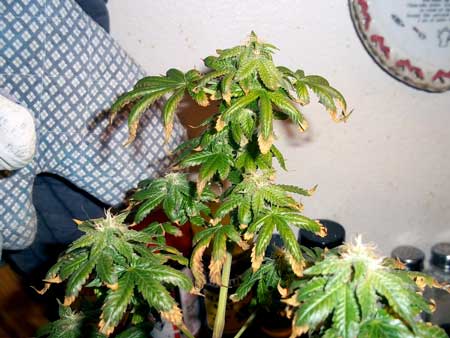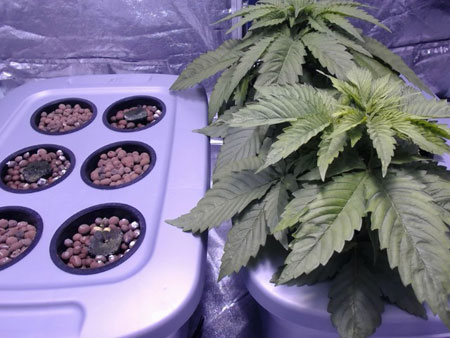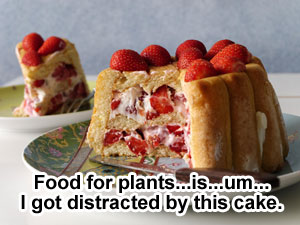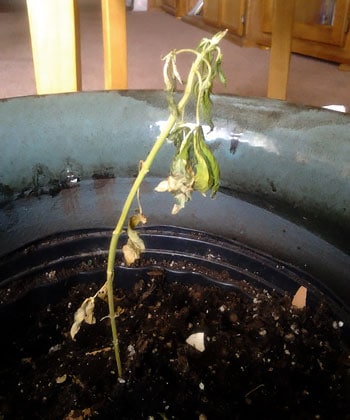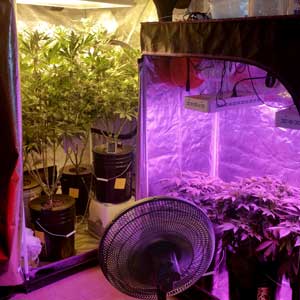by Sirius Fourside
I’m not ashamed to admit that my first few grows ended in complete failure. I had some bad information, and I combined that with some over-priced products and a dash of over-zealousness. For most of my early attempts, I ended up with plants that never got the chance to make even tiny buds I could harvest.
This plant was doing so well, but it suddenly got sick less than a month away from harvest!
After some time and practice, I can now grow more high-quality bud than I can use while expending a minimal amount of time and effort.
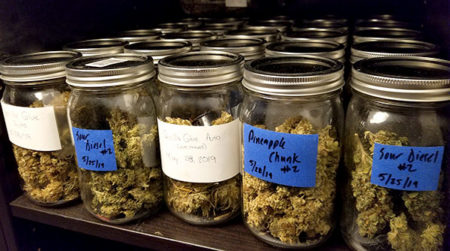
But I’m not special…I can honestly say that I’m no artist, prodigy, phenom, or anything even remotely close to those things. I just learned how to fix a few mistakes that were holding me back as a grower, and today I’m going to go through some of those common setbacks and make sure they don’t set you back!
Too Much Love

Is it possible to love something too much? I’d say Nebula might love cats too much. A baker in my neighborhood once told me I love desserts too much (that really happened, and he was right).
Loving your plants too much isn’t the problem, it’s the extraneous attention we give as a result of our love. When it comes to growing cannabis, that extra love can mean that growers check on their plants more often than needed. While there’s nothing wrong with checking on your plants regularly (that’s actually a good thing), these extra check-ins increase the chance that the grower is going to do something to the plants. A poke here, a trim there, maybe a little extra water…
The fact is, plants spend a lot of time not doing much. Or rather, they spend a lot of time doing things very slowly. That means that there will be stretches of time where there isn’t much for the grower to do besides give water.
Unfortunately, there isn’t a trick to beating the waiting game. Just treat these times like the perfect opportunity to practice patience, because the flowering stage requires a ton of it!
Is My Plant Really Thirsty?
The best instructions are specific. Well-made, specific instructions can teach anyone to do almost anything! Ideally, instructions can tell you precisely what you need to do from beginning to end.
Conversely, the bane of specific instructions is telling the reader to make a judgment call. And unfortunately, plant watering requires many judgment calls. How often do I water? How much do I water? Am I watering too much?
It would be nice to be able to tell growers, “Give your plants exacts .5 gallons of water every Monday and Thursday until harvest.” But there are too many variables (strain, container size, growing medium, etc.) to be able to give advice with that level of accuracy.
Luckily, watering is a breeze after a couple of attempts, and here are some tips to make it even easier.
Note: Make sure your pot/container has proper drainage. Excess water should be able to escape the bottom of the pot freely.
How to Water Cannabis Plants
- Soil – Wait until the top inch of your medium feels dry (or the pot feels light).
Coco coir – Aim to water plants every 1-2 days. If coco is staying wet for 3+ days, give less water at a time until plants get bigger and start drinking more. Don’t wait for your coco coir to dry out, but don’t water if the top 1/2″ (~1.5 cm) feels “wet”. If the container feels light, it’s time to water! - When watering with nutrients added to your water, make sure that 10-20% of the water comes out the bottom of your container. This helps prevent pH problems and excess nutrient buildup, amongst other things. If growing in soil with no added nutrients in the water, try to avoid runoff so you’re not accidentally washing away all the nutrients in your soil.
- Go back to Step 1.
Note: If you have small plants in a big container, give only a little water at first, maybe just a couple cups at a time. You want to be providing just enough water that it dries up within a few days. If the medium is completely dry by the next day, you need to give more water at a time. If it’s taking more than 3-4 days to dry out, you need to give less water at a time until the plant is a little bigger and drinking more.
Great instructions on watering: https://www.growweedeasy.com/how-often-water-marijuana
Playing the Light Game
There are plenty of ways to deliver light to your plant. Some growers are lucky enough to get their light straight from the sun. *grumble*
As indoor growers, we have to navigate the hotly-debated and sometimes confusing world of indoor grow lights. Every side claims to be the best for one reason or another: T5 users say their bulb is stealthy and low cost, LED and LEC lovers say their lights are the future, and those in the HPS camp claim their light is king!
Compare Grow Light Setups & Learn What Yields to Expect
The fact is, most types of grow lights will work just fine under the right circumstances. If you’re somewhat new to growing indoors and are having a hard time deciding on a grow light, here’s what I would recommend:
Small stealthy grows including PC grows, file cabinet grows, or new growers just trying to get a feel for the process
- T5s if you have the space for them, CFLs if you don’t (or to supplement the T5s)
- As long as you have at least 6′ of height, you can often use a small LED even in a very tight space
A small grow tent (2′ x 4’ or 3′ x 3′), regular closet or something similar
- T5s will work well in this scenario
- A 250w HPS or a 315 LEC would be tough to beat in a small space like this. A 400W HPS would work well in a 3’x3′ tent.
- LEDs between 120-400w (actual wattage) will work in this case, as well!
Larger grow tent (4’ x 4’ or bigger), walk-in closet or something similar
- One or several higher powered LEDs (minimum 400w total) would excel in this area.
- A 600w or 1000W HPS is the golden standard for this size of grow…for now.
Huge grow areas like a garage, shed or an entire room
- Multiple 1000w HPS lights are the standard for big indoor grow operations
- The sun. The price is unbeatable, and sunlight provides the perfect light for your plants!
Read more about different types of cannabis grow lights: https://www.growweedeasy.com/grow-lights
If you want to upgrade your grow lights, read this: https://www.growweedeasy.com/grow-light-upgrade-guide
Bad Seeds = Confidence Killer
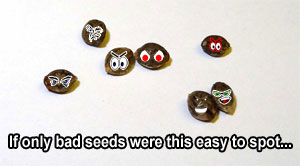
That’s because it can be tough to pinpoint when the seed itself is the problem. Most growers will blame themselves for a problem that shows up in their grow long before they assume it’s the seeds. I’m not immune to this problem, either. If a seed fails to germinate, I always wonder what I could’ve done, even if I provided the perfect growing conditions.
When I say “bad seeds”, I mean any seed that has a significantly higher chance of causing problems in a grow. That includes:
Bag Seed
- If you have weed with seeds in it, the seeds are likely an accident. Seeds you find in weed aren’t supposed to be there, which means that their genetics are a toss-up. Even if the seeds started with good parents, there’s no telling how high or (more likely) low the bud quality will be. Unfortunately, the only way to find out the quality of bag seed is to grow it. Some growers win the genetic lottery, but many others lose out.
Beat-up Seeds
- These are seeds you might get from a friend, or maybe you have them stashed somewhere and forgot how you got them. In either case, if the shell of the seed looks beat-up, it may not germinate as well or quickly as seeds stored in good conditions. That doesn’t mean you should toss beat-up seeds! Just be aware that they have a higher chance of not germinating.
Old Seeds
- Seeds are little nuggets of genetic material, hoping to grow into plants. And like (nearly) all other genetic material, it doesn’t last forever. Although seeds can be viable for quite a few years after they’re made, the chances of them successfully germinating goes down over time.
Check out the picture below. I planted all these seeds at the same time. The tub on the right has seeds that I planted within a week of receiving them in the mail. The tub on the left has a well-known strain with award-winning genetics…but the seeds were more than six years old from when I first bought them. Even though they all started germinating at the same time, the seeds on the left got outpaced by algae! Although they did eventually sprout (you can see a little seedling in the picture), they were too far behind and got axed.
Sometimes It’s Random!
- Even if you’re starting with the best, most fresh seed stock, occasionally you’ll get an individual seed or plant that just doesn’t grow as well or quickly as the others. Don’t beat yourself up if this happens. It’s always a good idea to sprout at least a few more seeds than you need in case you happen to run into a runt. If all your plants are healthy and growing fast except one, you can blame the seed!
Don’t deal with bad seeds: https://www.growweedeasy.com/seeds
Plant Food Should Be Easy, Right?
When it comes to cannabis nutrients, there are dozens of companies vying for your money. Why?
There are two main reasons:
- Nutrients don’t cost much to make, but they sell for higher prices. Profit!
- Cannabis plants have simple requirements, so it isn’t difficult to make nutrients that satisfy those requirements.
In short, this means that even a no-name company can make nutrients that work as well as high-priced nutrients. This lower barrier of entry combined with high profits makes for a lot of competing companies who all mostly do the same thing.
This can be confusing for newer growers because it means they have to wade through a bunch of products to find something that does the job.
If you’re in this spot, allow me to narrow down your choices to a few proven companies that work great for growing cannabis!
- General Hydroponics Flora Trio – Coco Coir & Hydroponics (Personal favorite)
- General Organics GO Box – Soil (Fully Organic)
- Fox Farms Nutrient Trio – Soil & Coco Coir (Mostly Organic)
- Botanicare – Soil & Hydroponics
- House & Garden – Soil, Coco Coir & Hydroponics (Premium)
- Canna Coco – Coco Coir
Important note: Although some growers associate nutrients with “feeding”, think of light as being closer to food for your plants than nutrients.
More information about picking the best cannabis nutrients: https://www.growweedeasy.com/nutrients
Trying Advanced Techniques Too Soon
There are some growing techniques that growers can try out on their first grow if they’re feeling adventurous enough. These simple plant training techniques (such as FIM’ing and low-stress training) are easy, have low time requirements, and are low risk. That means new growers can try them out without much consequence if things don’t go right.
On the other hand, there are techniques like Manifolding, ScrOG, and defoliation. These techniques can be tough to do, they carry a higher risk for your plants, and they can add days or weeks to your total grow time if done the wrong way.
Never try any new techniques if your plant is sick!
Although those advanced techniques are extremely rewarding in the right conditions, they should only be employed when the grower feels comfortable with growing cannabis without training. You also don’t want to use training techniques when they aren’t needed. Some people can grow untrained plants and still grow more weed than they can use.
For example, a grower could start a ScrOG setup and end up having to spend additional hours each week making sure the ScrOG net is being utilized correctly. Conversely, if that grower doesn’t need a lot of weed, they could be using a much simpler setup and still grow much more bud than they could use.
In short, keep it simple until you know you’re ready for something more advanced.
Getting Set Up
Getting your grow area set up is fun, but it comes with a cost that can quickly get out of control. There is a lot of money in selling growing equipment, especially since home cannabis cultivation isn’t fully mainstream yet, and the prices for some stuff is unbelievably high!
As a result, there is an overwhelming amount of choices when it comes to getting your equipment. Luckily, one of our greatest strengths as humans makes for a simple solution to this issue: our sociability!
What kind of grow setup should you get?
If you’re thinking about buying a particular product, make sure to do a little research before you buy it. Reviews can give you insights into products that you normally would have to purchase to find out. I’ve also learned a great deal of valuable information from the people who work at my local hydroponic stores. In fact, my first real setup was almost entirely comprised of suggestions from knowledgeable growers in my local hydro stores. They saved me the time of trying out products that could have potentially disappointed me, and instead helped me get gear so good I can’t leave it behind!
Don’t have anyone to ask in person? Learn what you need to start growing cannabis indoors. Or check out our forum!
What were some mistakes you made as a new grower? What information would you impart on new growers to help save them some time and make their grows better? Did I miss a big one? Let us know!
Jump to…
10-Step Quick Start to Growing Cannabis
Plant Training Techniques to Increase Yields
Where can I order seeds online?
7 Things I Wish Someone Had Told Me When I First Started Growing Weed

